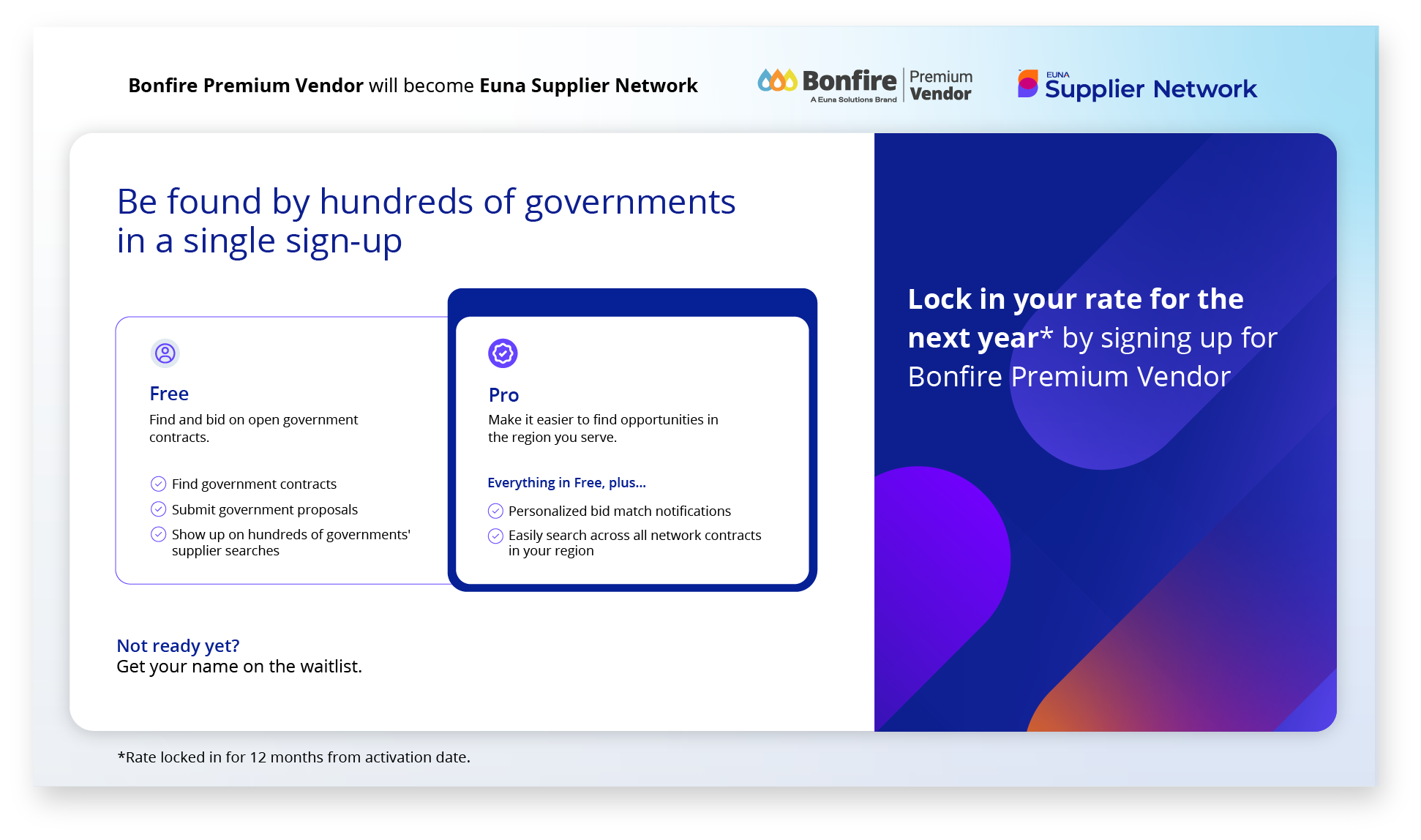Entering the world of public procurement can unlock rewarding opportunities for your business. Governments at all levels—municipal, county, state, and provincial—rely on suppliers like you to provide the essential goods and services that keep communities thriving.
But how do you get started? The government procurement process can often seem daunting, with its own set of rules, terminology, and procedures that are far different from selling to the private sector. But it doesn’t have to be —understanding and navigating the overall procurement process is well within reach.
In this guide, we’ll give you the key reasons why working with public sector is valuable, and walk you through the main stages of strategic public procurement, offering tips and best practices at each stage:
Why Should You Expand from Selling to Private Sector to Public Sector Organizations?
There are many benefits to breaking into the public sector, including those that are available by breaking into any new private sector market: gaining a competitive advantage, inspiring innovation, and networking and partnership opportunities. In addition, doing business with public sector has its own unique benefits as well:

Large Revenue Boost Potential
Governments are among the largest buyers of goods and services, with substantial budgets allocated to a wide range of needs. This translates into significant opportunities for suppliers across various industries.
Whether your business provides essential office supplies, cutting-edge IT services, construction materials, or healthcare products, there is a high demand in the public sector. Securing even a single contract with a government entity can result in a substantial boost to your revenue due to the sheer scale and consistency of their purchasing power.
Economic Stability
During economic downturns, government spending typically remains stable or even increases to stimulate the economy. This stability contrasts sharply with the private sector, where spending often decreases during economic recessions. By engaging with public sector organizations, your business can become more resilient to economic fluctuations.
Essentially, you are “recession-proofing” your business by creating a buffer against market volatility. This economic stability provided by government contracts can ensure that your business maintains steady operations and cash flow, even when other sectors and companies are experiencing financial turbulence.
Stable and Reliable Revenue Stream
Public sector contracts are often long-term, providing a steady and reliable source of income. Government agencies are less likely to face budget issues compared to private sector clients, ensuring timely payments and reducing the risk of financial instability.
This reliability allows for better financial planning and sustained growth over time. The predictability of government contracts can enable businesses to plan their finances with greater confidence, invest in new projects, and expand their operations without the fear of sudden revenue drops.
Diverse Contract Opportunities
From infrastructure projects and office supplies to IT services and healthcare products, the public sector requires a broad range of goods and services, offering diverse opportunities for businesses of all sizes and specialties. This diversity means that regardless of your industry, there is likely a niche within the public sector where your business can thrive.
Moreover, these opportunities are often published in advance, allowing businesses ample time to prepare and submit competitive bids. Engaging with the public sector can open doors to projects that align with your expertise and growth strategy, for example, thereby diversifying your revenue streams and expanding your market reach.
And of course, as you start securing government contracts, the process becomes easier and easier.
The Strategic Procurement Process: How To Get Started
Starting to do business with the public sector can seem overwhelming, as there could be various documents, qualifications, and starting points for a business looking to venture into this market. Below are consolidated steps of the overall procurement process that can help you navigate this new process, as well as key tips at each stage to make it even easier:

Step 1: Research Your Niche
Understanding the needs and demands of government agencies is crucial before diving into the public sector market. Begin by taking a proactive approach, researching whether your products or services align with what the government requires. This involves a thorough analysis of current and past government procurement opportunities. By examining closed opportunities, you can gain valuable insights into what has been previously purchased, identifying trends or recurring needs that might arise, even if they appear seasonal.
In addition to analyzing procurement trends, it’s beneficial to identify sub-contractors and competitors within your niche. Knowing who else operates in your space can help you understand the competitive landscape and find potential partners or subcontracting opportunities. This knowledge can also highlight gaps in the market that your business can fill, providing a strategic advantage when approaching government contracts. Engaging in comprehensive research ensures that your business is well-prepared to meet the specific demands of government agencies, increasing your chances of successfully entering the public sector market.
Pro Tips:
- Consider initially working as a sub-contractor to build your reputation and gain valuable experience and visibility within government circles.
- Use specialized software to narrow your search to your specific region and commodity codes.
- Leverage software to explore databases of past government bids and projects to understand market trends.
- Sign up for an account that delivers you personalized recommendations delivered directly to your inbox.
Step 2: Identify Most Relevant Public Sector Organizations
To maximize your chances of success, focus on public sector entities that present the highest opportunities for your business. Then, once you’ve decided it is a good opportunity for your business, begin familiarizing yourself with the procurement processes and terminologies used in public sector bids. Understanding how procurement works will help you navigate the landscape more effectively. Then, when these governments post a bid that is best fit for your business, you will feel most confident with all the terms and requirements.
Pro Tip:
- Consider leveraging a platform that allows you to follow and track specific projects of interest, with notifications that go straight to your inbox
Step 3: Submit A Bid
Submitting a bid to a public sector organization requires meticulous attention to detail and thorough preparation.
Read All Documentation
Start by reading all relevant information provided in the bid documentation, including background materials and specific requirements. This step is crucial as it sets the foundation for your entire proposal.
Conduct Detailed Research
Beyond the bid documentation, conduct additional research on the public sector agency issuing the bid. Understanding their mission, values, and past projects can provide valuable context that can be woven into your proposal. This knowledge can help you tailor your bid to highlight how your products or services align with the agency’s goals and priorities.
Develop a Strong Proposal
When writing your bid, you want to ensure it effectively positions your business in the right way towards the public sector. Structure your proposal clearly, addressing all required elements methodically. Highlight your company’s strengths, experience, and unique value proposition. Provide detailed descriptions of how your products or services meet the bid’s requirements, backed by evidence and examples from past projects. Ensure your proposal is professional, concise, and free of errors, as presentation quality can significantly impact the perception of your bid.
Submit Your Bid
Once complete, submit your bid to the appropriate portal or email as specified in the bid documentation. Ensure that you adhere to all submission guidelines, including format, deadlines, cost and required attachments.

Pro Tips:
- Consider watching The Anatomy of a Winning Bid webinar to learn the key aspects to include in your bid.
- Leverage online templates available, such as Bonfire’s Template for a Winning Government Bid.
- Understand the government’s perspective, which can be done through reading “Understanding Public Procurement Through a Government Lens” to align your bid with government expectations and standards.
- Use software that provides background information and current contracts to understand what the specific governments are looking for, allowing you to communicate easily, and access to all necessary documents in one convenient place.
Step 4: Keep up with stages before bid closure:
Once your bid is submitted, it’s important to stay engaged throughout the evaluation process. Participate actively during the Q&A period to address any queries from the procurement team. Be mindful of critical dates, such as presentation meetings, additional mandatory meetings, and the award date. Staying on top of these stages ensures you remain a strong contender and demonstrates your commitment and responsiveness to the procurement team.
Pro Tip:
- Leverage software that allows you to set up notifications to stay up-to-date without wasting time on manual tracking.
Step 5: Winning & Managing the Contract
Winning a public sector contract is just the beginning. The next step involves negotiating the terms of the contract to ensure it is favorable and manageable for your business. Be prepared for thorough negotiations and aim to establish clear and mutually beneficial terms in the deal. Effective contract management post-award is vital for meeting government standards and maintaining a positive working relationship.
Pro Tips:
- Leverage software to get insights and deep dives into past contracts to strengthen your negotiations.
- Identify and track past and expiring contracts for new opportunities.

Step 6: Renewals
Maintaining a strong relationship with the public sector agency throughout the contract period is essential for securing renewals. Deliver consistently high-quality services or products and ensure timely and effective communication. Public sector agencies often share information about contractors, so building a good reputation can influence future opportunities. Keep track of contract timelines and proactively discuss renewals to stay ahead of any potential competition.
Pro Tip:
- Ensure agencies can easily contact you and assess your performance for contract renewals.
Step 7: Losing the Opportunity
If you lose a deal, it’s not the end – you can use the learnings for the next procurement cycle. To learn more, read So You Lost the Bid Competition. Now What?
Why You May Consider Leveraging Specialized Software
According to GovData, a bid-writing company, 80% of self-submitted framework applications fail. Common reasons for these failures include inadequate technical documentation, incorrect responses, and missed deadlines. Utilizing technology can help address these issues and improve submission success rates.
Specifically, Bonfire Premium Vendor allows you access all documents and requirements for a bid, the ability to ask clarifying question, and notifications so you don’t miss critical details, all with one easy platform.

Try Premium Vendor Today
All the above tips can be achieved with Bonfire Premium Vendor.



